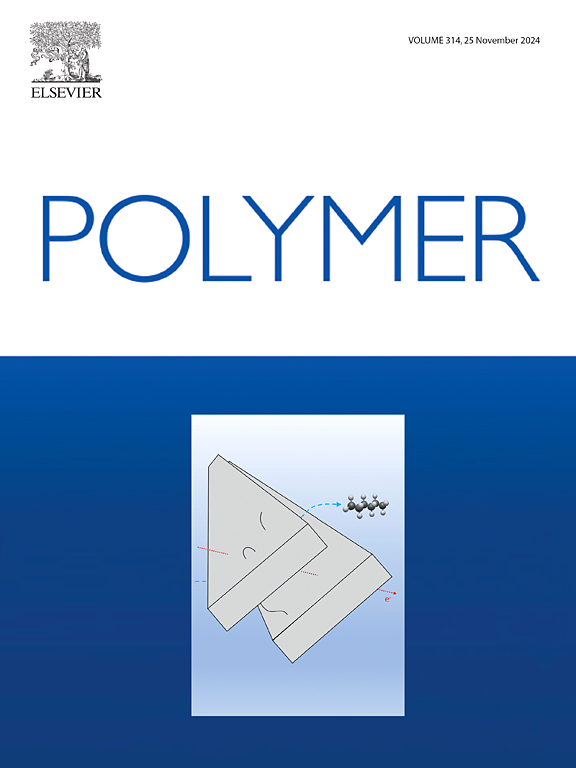PA11的双重屈服:区分非晶和结晶组分的力学贡献
IF 4.5
2区 化学
Q2 POLYMER SCIENCE
引用次数: 0
摘要
在Tg以下的拉伸变形过程中,PA11的应力-应变曲线呈现出两个明显的连续屈服点。这种现象被称为双屈服(DY),在其他半结晶聚合物如PA6或PE中也被观察到。研究了这种现象的成因及其与PA11非晶相和结晶相变形机制的关系。在拉伸试验之前或期间,对PA11样品进行了有针对性的改性,并系统地监测了对两个屈服点的影响。在老化、温度/速率或塑性诱导的非晶相分子迁移率与第一屈服点之间建立了紧密的联系。另一方面,由于退火或熔体缓慢冷却,第二屈服点显然对晶体重组敏感。然而,它对非晶相中迁移率的变化也很敏感。本文提出了一个描述DY现象的热力学激活模型,该模型预测了σy2的非平凡演化,并表明非晶相中的塑性流动必须首先被激活才能启动结晶机制。更普遍的新见解,复杂的微观变形机制,在半结晶热塑性塑料提供了。本文章由计算机程序翻译,如有差异,请以英文原文为准。


Double yielding in PA11: discriminating the mechanical contributions of the amorphous and crystalline fractions
The stress-strain curve of PA11 exhibits two well-distinct successive yield points during tensile deformation below Tg. This phenomenon, denoted double yielding (DY), has been observed as well in other semicrystalline polymers such as PA6 or PE. An investigation of the origin of such phenomenon and its relationship to the deformation mechanisms occurring in the amorphous and crystalline phases of PA11 has been conducted. PA11 samples were purposely modified prior to or during tensile testing and the resulting effects on the two yield points were systematically monitored. A strong link between ageing-, temperature/rate- or plasticity-induced molecular mobility in the amorphous phase and the first yield point has been established. On the other hand, the second yield point is clearly sensitive to crystalline restructuring due to annealing or slow cooling from the melt. However, it is also sensitive to changes in mobility in the amorphous phase. A thermomechanical activation model describing the DY phenomenon that predicts the non-trivial evolution of σy2 and suggests that plastic flow in the amorphous phase must first be activated to initiate crystalline mechanisms has been proposed. More generally new insights into the complex microscopic deformation mechanisms in semicrystalline thermoplastics have been provided.
求助全文
通过发布文献求助,成功后即可免费获取论文全文。
去求助
来源期刊

Polymer
化学-高分子科学
CiteScore
7.90
自引率
8.70%
发文量
959
审稿时长
32 days
期刊介绍:
Polymer is an interdisciplinary journal dedicated to publishing innovative and significant advances in Polymer Physics, Chemistry and Technology. We welcome submissions on polymer hybrids, nanocomposites, characterisation and self-assembly. Polymer also publishes work on the technological application of polymers in energy and optoelectronics.
The main scope is covered but not limited to the following core areas:
Polymer Materials
Nanocomposites and hybrid nanomaterials
Polymer blends, films, fibres, networks and porous materials
Physical Characterization
Characterisation, modelling and simulation* of molecular and materials properties in bulk, solution, and thin films
Polymer Engineering
Advanced multiscale processing methods
Polymer Synthesis, Modification and Self-assembly
Including designer polymer architectures, mechanisms and kinetics, and supramolecular polymerization
Technological Applications
Polymers for energy generation and storage
Polymer membranes for separation technology
Polymers for opto- and microelectronics.
 求助内容:
求助内容: 应助结果提醒方式:
应助结果提醒方式:


